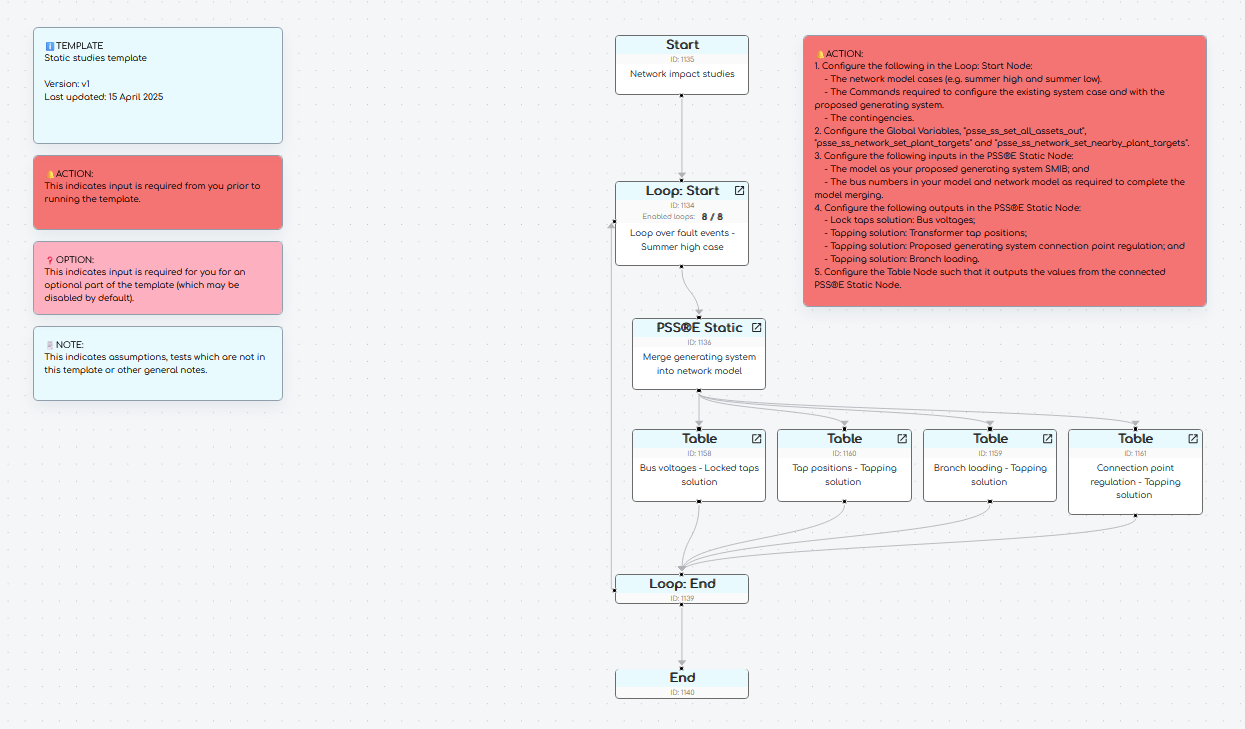Template: AEMO static studies

Template version: v2
Country:

AU
Software required:
Source: AEMC | National Electricity Rules | Version 222 | 19 December 2024

Background
During the generation interconnection process, it is important to understand the impact of the proposed generating system on static study phenomena (e.g. bus voltages and thermal line loading) during both normal operating conditions and contingencies. Static studies are fundamental to the generation interconnection process and should be completed prior to any dynamic studies. Static studies are typically used for the following:
| Use | Description | Project stage |
|---|---|---|
| Capacity assessments | Static studies are useful to quickly understand the available capacity in a particular part of the network and explore help estimate potential generating system sizing. Typically these studies primarily consider line and transformer thermal loading during normal network operating conditions (i.e. 'N' condition during summer/winter/autumn/spring low/high demand). | Preliminary enquiry stage |
| Detailed static study assessment | Static studies are useful to investigate the network impact of the proposed generating system, once an approximate size has been chosen. These studies involve a detailed investigation into bus voltage change/limit violations, transformer tap usage, connection point regulation and initial control strategy (e.g. voltage droop control mode v.s. PF control mode), transformer thermal loading and line thermal loading under multiple contingencies. Mitigation strategies (e.g. run-back schemes, line reconductoring, a new transformer) must be proposed to solve any identified issues (e.g. thermal line loading violations under a contingency). | Detailed enquiry stage and Connection application stage (S5.2.5.12) |
Together, these two types of static studies can help to answer the key question at the outset of any new electricity generation project: “How many megawatts?”.
Determining the right size for a proposed generator is complex and also depends on many other non‑grid factors which can't be answered using static studies, such as:
- Current and forecast electricity prices
- Generator technology and market participation (e.g. FCAS participation)
- Project financing
- Development approvals
- Land costs
- and more...
Additionally, although static studies are a useful tool to assess local thermal constraint risks, these studies can't be relied upon to determine the overall technical constraint risk for a proposed generator. There are many other factors which need to be considered and which are heavily dependent on the local market and network conditions, such as:
- Curtailment due to unfavourable electricity prices
- Curtailment due to minimum inertial requirements
- Curtailment due to local utility network security agreements
- Curtailment due to other types of technical constraint
- and more...
Currently, this template assumes that all generators which are to be considered as part of the studies are already merged into the network model and the model is stable. See our example for more information on merging multiple generators into a network model.
Configuration
Capacity assessment
Capacity assessments are useful in the early stages of project development, where you want to understand the available capacity in a particular part of the network and estimate potential generating system sizing. The larger the generator, the greater the likelihood of technical (grid) curtailment.
You may want answers to high-level questions such as:
- Could this area of the network accommodate a 100MW or 1GW generating system?
- At what generating system size will there likely be local network constraints?
The purpose of the assessment is to:
- Provide engineers with a quick understanding of how adding a proposed generator affects local branch loadings.
- Identify potential network limitations before detailed studies are undertaken.
- Serve as an initial sanity check for generator sizing and connection feasibility.
The intent of this assessment is to quickly provide the engineer with an understanding of the impact on branch loadings in the surrounding region and how power is distributed when adding a proposed generating system of various sizes. In this assessment, contingencies are not applied; the network is evaluated in its System Normal configuration. This approach provides insight into how the loading on nearby branches changes as the size of the proposed generator increases under the most common system setup. The assessment should assist the engineer in determining a reasonable maximum size for the proposed generating system. Specifically, if the addition of a proposed generator at the chosen location results in a thermal overload of network infrastructure, then the proposed generator likely needs to be reduced in size or the network infrastructure needs to be upgraded.
Additionally, changes in network power flow direction are not always intuitive for an engineer to assess, even when they are familiar with the network topology. When evaluating a new generating system, it is useful to understand what proportion of the additional power will flow through the various network corridors toward the load centres. Although this depends on the specific configuration, this assessment considers only the System Normal state. Even so, it remains valuable as an initial evaluation, since System Normal represents the most common operating condition.
The power system is generally operated with consideration of an N-1 condition, meaning it must remain secure following the loss of a credible element. Consequently, investigation of the network only in its System Normal configuration is not sufficient. Nevertheless, this assessment is valuable for identifying cases where a proposed generator is likely unsuitable without requiring more detailed studies. For instance, if a generator of a given size is not feasible under System Normal conditions, it will certainly not be feasible under N-1 conditions.
An advantage of this capacity assessment is its ability to simply and rapidly evaluate multiple parts of the network with different generator sizes to understand their local impact. Once the engineer has greater confidence in the generator size and connection location, it is recommended to proceed with further detailed static study assessment, as outlined in the following section.
- Ensure that the slack bus (or reference generator) in the network is not in close proximity to the new proposed generating system. If the slack bus is electrically close to the proposed generator it may mask the effect of the proposed generator on the wider network. It is recommended to set the slack bus to be far away from the new generating system.
Detailed static study assessment
Unlike the capacity assessment, in this assessment the new generating system is a fixed MW size. The detailed static study assessment explore the several network phenomena across a variety of contingencies. The studies are completed for the existing system and with the proposed generating system.
- Bus voltages - Locked taps solution: Bus voltages must be maintained within a specified range following any credible contingency. By applying a contingency and then solving the network with locked taps, this investigates the ability of the network to maintain voltages within the first ≈30 seconds after the contingency which is the time prior to any mechanical on-load tap changer (OLTC) effects.
- Tap positions - Tapping solution: Bus voltages must be maintained within a specified range following any credible contingency. A critical part of this voltage control is achieved by using transformers with on-load tap changer (OLTC). By applying a contingency and then solving the network with tapping, we can see if transformers are at their tap position limits and the network is therefore at risk of losing its ability to regulate voltage further.
- Branch loading - Tapping solution: Long-term thermal loading of transformers and lines must be maintained within their asset rating limits. By applying a contingency and then solving the network with tapping, we can see if transformers and lines are at risk of being thermally overloaded.
- Connection point regulation - Tapping solution: During the studies, it is important to verify that the proposed generating system is regulating active power and reactive power at its connection point in accordance with the agreed control strategies.
We assume that your generating system and other nearby generating system may regulate voltage during the locked tap solution (e.g. a CONTROL Command for voltage droop control mode). This is consistent with all other generators in the network in direct voltage control. This assumes that the generating system reactive power system control mode has a settling time to the disturbance of much less than the time for OLTC and other similar network elements to operate.
- For contingencies which involve reducing the size of the generating system (e.g. 50% trip of proposed generating system), the generating system control after the contingency may be different. Many PPC active power and reactive power control systems will scale their settings based on the number of available inverters (e.g. a droop curve percentage may remain as 4%, but the Q base may scale down 50% if 50% of inverters are unavailable).
- Different NSPs may have different requirements or special formatting for detailed enquiry and S5.2.5.12 submissions. Please refer to your steady state data pack for project-specific requirements.
What is a runback scheme? Can I use a runback scheme?
A runback scheme is a control scheme whereby the proposed generator's output may be automatically reduced (i.e. runback) following a particular contingency or under particular network conditions. The detailed static study assessment is useful to highlight under which contingencies a runback may be needed to avoid the proposed generator being subject to a particular pre-contingent technical constraint or size limitation. However, there is often significant engineering complexity and cost associated with implementing a runback scheme. Modelling and eventual implementation of such schemes should be discussed with your local utility.
Assumptions
- Some GPS tests require a PSS®E model of the NEM (colloquially known as an 'OPDMS snapshot' in the industry). We do not provide these snapshots. You will have to provide your own pre-tuned dynamic base cases for these tests.
Sources
Revision history
Version 2 | 1 December 2025
New- Added 'Capacity assessment' template.
- Detailed static study assessment: Analysis Node for branch loading.
- Detailed static study assessment: Included branch loading [MVA] and rating [MVA] in the Table output.
- Detailed static study assessment: Fixed minor Internode issue in Table Node.
Version 1 | 28 April 2025
- First release.